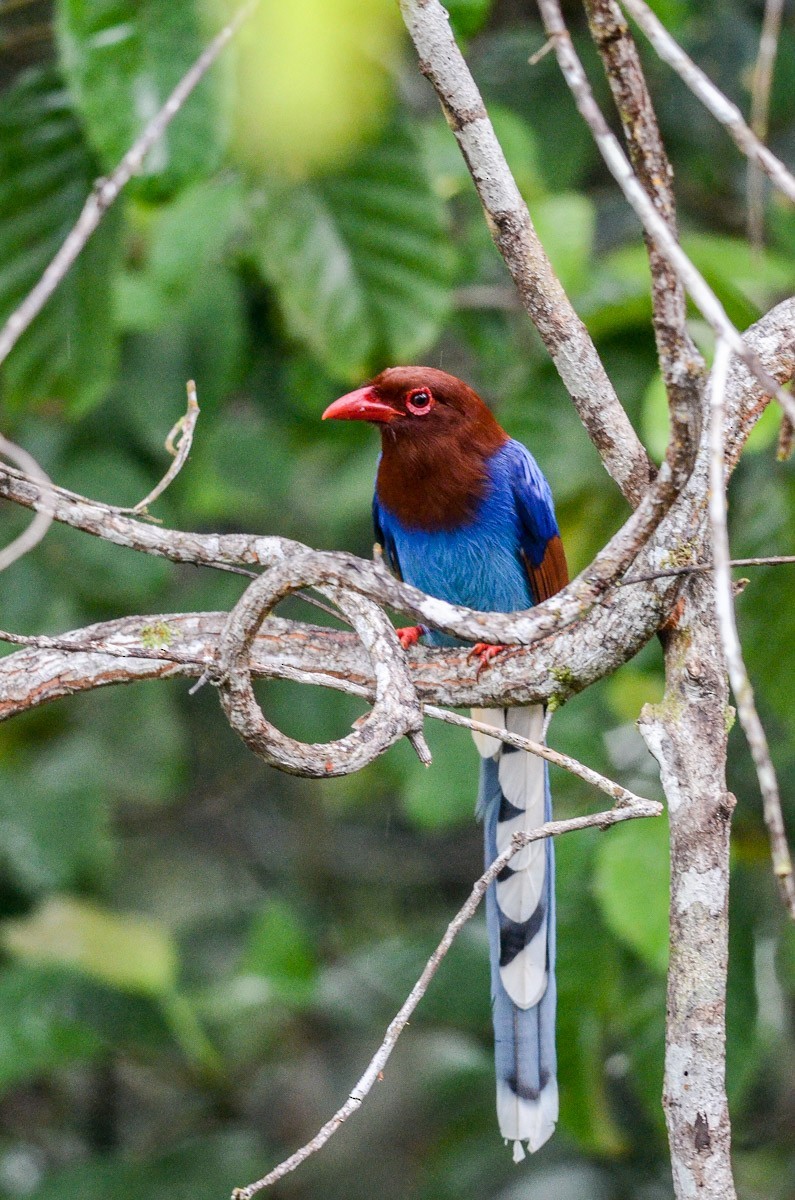Sri Lanka Blue Magpie
A species of Blue Magpies, Also known as Ceylon Magpie Scientific name : Urocissa ornata Genus : Blue Magpies
Sri Lanka Blue Magpie, A species of Blue Magpies
Also known as:
Ceylon Magpie
Botanical name: Urocissa ornata
Genus: Blue Magpies
Content
Description General Info
 Photo By Nikolaj Mølgaard Thomsen
Photo By Nikolaj Mølgaard Thomsen Description
The Sri Lanka blue magpie measures between 42–47 cm in size, and is larger than a mynah but smaller than a crow, with a sturdy bill. Its plumage is bright blue, with a reddish-brown or chestnut head, neck, and wing. The blue tail is long and graduated, with a white tip. The bill, legs, feet, and featherless eye ring of this species are all vibrant red. Both the male and female of the species share this description. The juvenile of this species has a plumage similar to that of an adult, but overall duller, with a brown eye ring and a greyish hue to its blue feathers, especially on its underside. Moulting season for Sri Lanka blue magpies is from August to November. 
Size
47 cm
Nest Placement
Tree
Feeding Habits
Sri Lanka Blue Magpie primarily consume insects, frogs, and small lizards, supplementing with fruits. They forage with strong legs, hang upside down, and remove caterpillar hairs before eating. Occasionally, they eat bird eggs or chicks.
Habitat
The sri Lanka Blue Magpie thrives primarily in tropical broadleaf evergreen forests, which typically feature dense, lush foliage and a multilayered forest structure. They are also found at the fringes of agricultural areas, such as tea plantations, where the edges of natural forests meet cultivated lands. The species' habitat is characterized by high humidity and ample rainfall, supporting a rich biodiversity that includes the sri Lanka Blue Magpie's diverse diet.
Dite type
Omnivorous
General Info
Feeding Habits
Bird food type
Behavior
In spite of their avoidance of human-disturbed habitats, research conducted at a highly visited nature trail in a forest reserve in Sri Lanka has shown that the Sri Lanka blue magpie tolerates and is even attracted to the presence of humans. In response to low and moderate levels of recreational disturbance, and small to medium-sized groups of human visitors, numbers of Sri Lanka blue magpies increased, unlike other birds included in the study. A group of individuals were often observed waiting near trails, expecting to be fed by groups of human visitors. 
Distribution Area
This species is endemic to Sri Lanka, where it is found in tall, undisturbed forest in the mountains, foothills, and adjoining lowlands of the wet zone. It is found from elevations of 2,135m to below 150m. It is not often seen in disturbed habitat such as gardens or plantations. Surveys conducted from 2004-2006 found individuals of this species in 38 separate forest patches contained within 6 forest complexes within its range in the wet zone of Southern Sri Lanka. 
Species Status
The Sri Lanka blue magpie is listed as Vulnerable, due to the fragmentation and ongoing decline of the population. Surveys performed in 2004-2006 estimate the population at 10,181-19,765 individuals, although their breeding strategy of monogamy and co-operative breeding has led to that estimate being reduced to 9,500-19,500 individuals total to reflect their effective population size. The main threat to the survival of the Sri Lanka blue magpie is habitat loss due to forest being cleared for agricultural land, mines, logging, and human settlement. A moratorium on logging in wet zones in 1990, plus the legal protection of this species in Sri Lanka have the potential to slow their population decline, but air pollution causing forest die-back and the use of biocides in the hill country continue to threaten the Sri Lanka blue magpie. It has been suggested that one of the factors preventing the Sri Lanka blue magpie from moving into disturbed habitat is the presence of another bird, the Asian koel (Eudynamys scolopaceus) which is a brood-parasite. 

 Photo By Nikolaj Mølgaard Thomsen
Photo By Nikolaj Mølgaard Thomsen Scientific Classification
Phylum
Chordates Class
Birds Order
Perching birds Family
Crows and jays Genus
Blue Magpies Species
Sri Lanka Blue Magpie